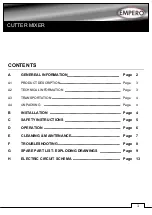
5
18
20
20
21
22
23
23
24
24
25
26
27
MASTER SECTION
11. STEREO
GRAPHIC
EQ:
There are
two graphic EQs each with 9 adjustable bands;
one is for the MAIN mix
and the other is for the MONITOR mix. With the faders you can boost or cut the selected frequency by +/-15 dB
at the indicated frequencies. When all faders are at the center position, the equalizer is disabled.
12.
FEEDBACK TERMINATOR Button
(MONITOR mix)
- This button activates the feedback detection in the
monitor signal path. Feedback will be identified at a certain frequency when
the corresponding fader LED lights
up. Feedback produces an unpleasant
speaker "howling" or "whistling". In order to eliminate feedback,
turn
down the corresponding fader until feedback
disappears.
13.
MONITOR LEVEL LED Display-
This LED display
will show you the monitor output level. Make sure
that the
+10 LED only lights up occasionally. The
optimal level is between -10 and
0 on the LED. If
only the -30 LED lights up or doesn't come on, your
S/N ratio will be degraded.
14.
FEEDBACK TERMINATOR Button (MAIN mix)
-
This button activates the feedback detection function
in the
Main mix signal path. Feedback will be
identified at a certain frequency when
the
corresponding fader LED lights up. Feedback
produces an unpleasant
speaker "howling" or
"whistling". In order to eliminate feedback,
turn down
the corresponding fader until feedback disappears.
15.
MAIN mix LEVEL LED Display-
This LED display
will show you the Main mix output level. Make sure that the
+10 LED only lights up occasionally. The optimal
level is between -10 and 0 on the LED. If only the -30 LED lights up or doesn't not come on your S/N ratio
will
be degraded.
16.
MONITOR LEVEL –
This adjusts the volume of the Monitor output.
17. MASTER
LEVEL-
This adjusts the overall volume of the MAIN output and HEADPHONE out.
18. PHANTOM
POWER
–
This switch activates and deactivates phantom power. When
activated, phantom power su48V to the XLR mic inputs and the LED above the switch
will be lit. Please note that most dynamic microphones do not require phantom power, while
most condenser microphones do. Consult your microphone’s documentation to find out
whether it needs phantom power.
MASTER I/O (INPUT/OUTPUT)
19.
AMPLIFIER Mode Switch-
This switch provides three modes: MAIN/MAIN, MAIN/MONITOR and BRIDGE.
Select any one of these modes to route the signals to the corresponding jacks
according to the speaker panel
connection. This switch only affects the rear panel outputs. The front panels outputs are unaffected by this
switch.
•
MAIN/MAIN-
When the switch is set to this, the amp will send the main mix to the rear panel Speakon
jacks or the rear panel ¼” jacks.
•
MAIN/MON-
When the switch is set to this, the amp will send the main mix to the OUTPUT 1 Speakon
jack and 1/4'”jack. The monitor mix will be sent to the OUTPUT 2 Speakon jack.
•
BRIDGE-
When the switch is set to this, the amp will send the main mix to the rear panel OUTPUT 2
Speakon jack.
20.
MAIN OUTPUTS –
These 1/4" line level outputs can be connected to powered speakers or an amplifier
system. The level of these outputs is controlled by the Main Level knob.
21. MONITOR
OUTPUT-
This line level
balanced output is used to connect the
input of an external amplifier
or powered
speaker.
22. PHONES
–
Connect your 1/4" stereo
headphones to this output.
23. 2-TRACK
INPUTS
–
Connect these to the
outputs of an external sound source using
standard stereo RCA cables (sold
separately). You can send this to channels 9/10 (using the 2-TRACK to 9/10 switch) or to the main outputs
(using the 2-TRACK TO MAIN switch).
24. 2-TRACK
OUTPUTS
–
You may connect these outputs to the inputs of an external recording device using a
standard stereo RCA cable (sold separately).
25. AUX
OUT
- This outputs the line level signal sent from a channel’s AUX1 Pre knob to the Monitor Output. You
can use it to feed the inputs of another stereo multi-effects unit (using a Y-type cable sold separately).
26. STEREO
RETURN
- This stereo jack is used to route a stereo signal to the Main, Monitor and Phones outputs
by adjusting the FX TO MAIN and FX TO MON knobs.
27. 2-TRACK
TO–
If you position this switch to the left you will route the signal fed into the TAPE
IN sockets into
CH9~10 path, and the signal will be affected by channel level
control, channel EQ, DSP send, and MAIN level
control. Positioning this
switch to the right will route the TAPE IN signal into Main mix bus. In this case
signal
will be affected only by Main level control.
11
11
12
13
14
15
16
17






























